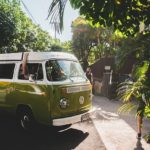Heat and Dust in Australia’s Kimberley Region
Australia was the final stop in my quest to visit all seven continents before turning 40. I prefer remote landscapes over cities, so I joined a nine-day Kimberley camping adventure with Intrepid Travel. I planned my visit in October, at the end of the dry season, when the temperatures reach over 40ºC/104ºF. I would highly recommend visiting earlier in the dry season, which lasts from May to October. My tour departed from Broome, a charming seaside town whose tourist season was waning, meaning I had Cable Beach practically to myself (accessible by the local bus) and no crowds as I cozied up to a bar to order the locally renowned mango beer.
After a long morning drive we reached our first destination in the Kimberley – Tunnel Creek, a curvy, cave-like path naturally carved through a mountain. To get there we had to scamper over some boulders and gave a wide berth to a brown snake soaking in the midday sun. The temperatures were significantly cooler there, and we splashed through ankle-deep puddles. The only things I needed for exploring Tunnel Creek were a headlamp/torch and a pair of shoes that can get wet. It’s a short walk, full of ragged crags and mysteries that were only unveiled in the passing light of my headlamp, like the beady eyes of a freshwater crocodile resting in the water!
Later that evening at the campground, our guide told us to walk into Windjana Gorge at dusk and stop after about ten minutes at the pond with the “freshies.” He wouldn’t tell us why. After sitting by the pond for a while in a heat-induced stupor, movement drew my attention to the trees on the other side of the pond. Bats hanging on the dense canopy suddenly began stretching their wings and fleeing into the open air. They departed in waves, thousands of them, in a fashion so organized that it appeared to be orchestrated solely for our benefit. They swarmed high above our heads, and never got uncomfortably close. Instead, they headed into the night sky, instinctively finding their way between the tall, narrow walls of the gorge. Black dots contrasting against the purple sunset sky.
Bats hanging on the dense canopy suddenly began stretching their wings and fleeing into the open air. They departed in waves, thousands of them, in a fashion so organized that it appeared to be orchestrated solely for our benefit.
Camping in the Kimberley included setting up tents, and we were diligent about keeping them tightly zipped and critter free. Intrepid provided swags, which are canvas-covered sleeping pads that roll up when not in use. I purchased a cheap sleeping bag that I didn’t need for warmth, but was glad that I had it to lay over the bedroll to make sleeping more comfortable. I woke up each morning at around 4am; there was little choice in the matter. The rising sun turned my tent into an oven, and nearby birds greeted the morning with their boisterous calls.
Our tour included several watering holes where we relaxed in the midday sun, or cooled off in the middle of a hike. Some featured but a trickle of a waterfall, such as Bell Gorge and Emma Gorge. Many, such as the small natural pools at El Questro, featured small fish that snacked on our toes and legs, but didn’t really hurt. Despite bringing plenty of clothes, I found myself wearing my bathing suit every day. It was too hot to wear anything else, I was always prepared for a swim, and hiking in a wet bathing suit was fine, not the soggy, chafing experience I dreaded it would be.
Other than snakes, crocs, bats, and birds, we saw plenty of less fearful and noisy animals, including wallabies and a wallaroo with a joey. During a boat ride at Lake Argyle, the local archer fish even spit as us!
Our tour ended in Darwin, a jolt after nine days of seeing nothing but baobab trees, emerald pools, termite mounds, the occasional brush fire, and rock formations.
The most otherworldly spot in the Kimberley was Purnululu National Park, also called the Bungle Bungles. We hiked among the rolling hills, which are orange and black striped like something out of a Dr. Seuss book. We sought refuge from the sun in the cavernous Cathedral Gorge, a sandy oasis with rock walls so high that they completely blocked out the sun. We marched through Echidna Chasm, the walls narrowing in on us with each step we took until we could go no further. I wore sneakers or water sandals the entire time, never needing or wanting to wear heavier hiking boots. I also wore a long-sleeved white button down. While the extra layer may sound hot, it did a wonderful job of keeping the direct sun off my skin.
Our tour ended in Darwin, a jolt after nine days of seeing nothing but baobab trees, emerald pools, termite mounds, the occasional brush fire, and rock formations. Darwin was a touristy place with raucous, air conditioned bars overflowing with young travelers. I instantly missed the strange, noisy, oftentimes uncomfortable peace of the Kimberley.








